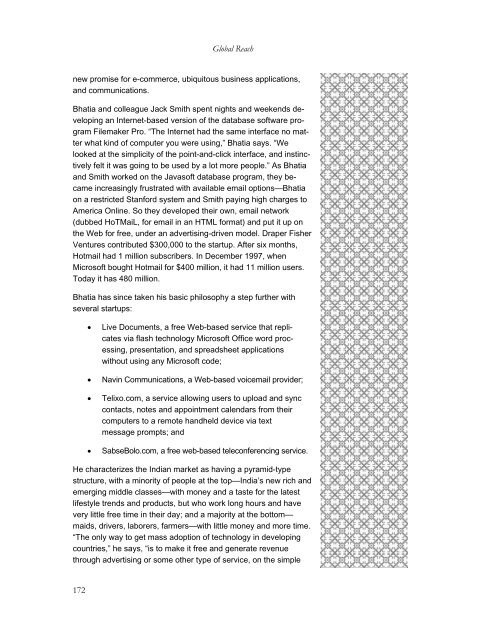PDF: 2962 pages, 5.2 MB - Bay Area Council Economic Institute
PDF: 2962 pages, 5.2 MB - Bay Area Council Economic Institute
PDF: 2962 pages, 5.2 MB - Bay Area Council Economic Institute
You also want an ePaper? Increase the reach of your titles
YUMPU automatically turns print PDFs into web optimized ePapers that Google loves.
Global Reach<br />
new promise for e-commerce, ubiquitous business applications,<br />
and communications.<br />
Bhatia and colleague Jack Smith spent nights and weekends developing<br />
an Internet-based version of the database software program<br />
Filemaker Pro. “The Internet had the same interface no matter<br />
what kind of computer you were using,” Bhatia says. “We<br />
looked at the simplicity of the point-and-click interface, and instinctively<br />
felt it was going to be used by a lot more people.” As Bhatia<br />
and Smith worked on the Javasoft database program, they became<br />
increasingly frustrated with available email options—Bhatia<br />
on a restricted Stanford system and Smith paying high charges to<br />
America Online. So they developed their own, email network<br />
(dubbed HoTMaiL, for email in an HTML format) and put it up on<br />
the Web for free, under an advertising-driven model. Draper Fisher<br />
Ventures contributed $300,000 to the startup. After six months,<br />
Hotmail had 1 million subscribers. In December 1997, when<br />
Microsoft bought Hotmail for $400 million, it had 11 million users.<br />
Today it has 480 million.<br />
Bhatia has since taken his basic philosophy a step further with<br />
several startups:<br />
<br />
<br />
<br />
<br />
Live Documents, a free Web-based service that replicates<br />
via flash technology Microsoft Office word processing,<br />
presentation, and spreadsheet applications<br />
without using any Microsoft code;<br />
Navin Communications, a Web-based voicemail provider;<br />
Telixo.com, a service allowing users to upload and sync<br />
contacts, notes and appointment calendars from their<br />
computers to a remote handheld device via text<br />
message prompts; and<br />
SabseBolo.com, a free web-based teleconferencing service.<br />
He characterizes the Indian market as having a pyramid-type<br />
structure, with a minority of people at the top—India’s new rich and<br />
emerging middle classes—with money and a taste for the latest<br />
lifestyle trends and products, but who work long hours and have<br />
very little free time in their day; and a majority at the bottom—<br />
maids, drivers, laborers, farmers—with little money and more time.<br />
“The only way to get mass adoption of technology in developing<br />
countries,” he says, “is to make it free and generate revenue<br />
through advertising or some other type of service, on the simple<br />
172








